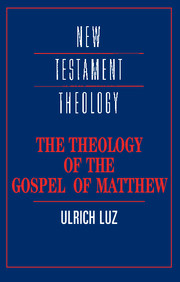Book contents
- Frontmatter
- Contents
- Editor's preface
- Author's preface
- List of abbreviations
- 1 The Book
- 2 The Prologue (Matthew 1:1 – 4:22)
- 3 The discourse on the Mount (Matthew 5 – 7)
- 4 The ministry of the Messiah and his disciples in Israel (Matthew 8:1 – 11:30)
- 5 The origins of the community of disciples in Israel (Matthew 12:1 – 16:20)
- 6 The life of the community of disciples (Matthew 16:21 – 20:34)
- 7 The final reckoning with Israel and the judgement of the community (Matthew 21:1–25:46)
- 8 Passion and Easter (Matthew 26 – 28)
- 9 Concluding thoughts
- Further reading
- Subject index
- Index of citations from Matthew
1 - The Book
Published online by Cambridge University Press: 05 June 2012
- Frontmatter
- Contents
- Editor's preface
- Author's preface
- List of abbreviations
- 1 The Book
- 2 The Prologue (Matthew 1:1 – 4:22)
- 3 The discourse on the Mount (Matthew 5 – 7)
- 4 The ministry of the Messiah and his disciples in Israel (Matthew 8:1 – 11:30)
- 5 The origins of the community of disciples in Israel (Matthew 12:1 – 16:20)
- 6 The life of the community of disciples (Matthew 16:21 – 20:34)
- 7 The final reckoning with Israel and the judgement of the community (Matthew 21:1–25:46)
- 8 Passion and Easter (Matthew 26 – 28)
- 9 Concluding thoughts
- Further reading
- Subject index
- Index of citations from Matthew
Summary
MATTHEW'S GOSPEL AS A COHERENT BOOK
Today the Gospels are very seldom read in their entirety, from beginning to end. Laypeople prefer instead to choose isolated passages for their daily Bible readings, perhaps from a book of lections. Pastors do much the same: they need excerpts from the Gospels for their sermons or instruction. Theologians often use the Gospels (and other biblical texts) as a sort of quarry or ‘documentation centre’, employing passages from them to substantiate one or another theological verity. This state of affairs can even be felt in Gospel research: here and there the Gospels have been described as books of pericopes or lectionaries, that is, as collections of the traditions about Jesus. Hardly anything could be more incorrect than this assumption.
There are several reasons why the Gospels are only rarely read from beginning to end. One very important reason is that we know them well – or think we do. Books we know well lack the element of excitement we feel, for example, when reading a novel or short story. Instead, one prefers to read isolated passages in order to refresh the memory. But this is to overlook one very important consideration: all the Gospels, though perhaps least of all Luke's, have an internal ‘line of tension’ extending from beginning to end.
- Type
- Chapter
- Information
- The Theology of the Gospel of Matthew , pp. 1 - 21Publisher: Cambridge University PressPrint publication year: 1995

